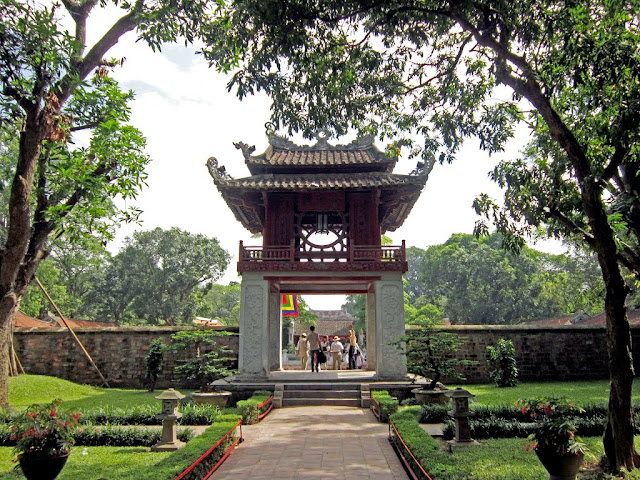As the capital of Vietnam, Hanoi is home to a large number of must-see attractions. Museums and pagodas scatter the city and Hoan Kiem Lake serves as the centre point to reach just anywhere. Hanoi Old Quarter, the cultural, dining, entertainment and shopping heart of the city is worth the majority of your time to discover. If you plan a trip to Hanoi, spare at least a couple of days to explore the city.
TRAN
QUOC PAGODA
Located on a small penisula on the East side
of West Lake, Tran Quoc Pagoda is regarded as the most ancient pagoda in Hanoi
with its history line of more than 1,500 years.
Located on a small penisula on the East side
of West Lake, Tran Quoc Pagoda is regarded as the most ancient pagoda in Hanoi
with its history line of more than 1,500 years. The architecture of this
Buddhist center is a subtle combination between the solemn and beautiful
landscape on the peaceful and quiet ambiance of West Lake’s surface. Thanks to
these historical and architectural values, Tran Quoc Pagoda attracts many
tourists to pay a visit, both inside and outside of Vietnam.
LY
QUOC SU PAGODA
Located at 50 Ly Quoc Su Street in the Old
Quarter, only 50m from St Joseph's Cathedral, Ly Quoc Su Pagoda is one of the
oldest ones of its kind in Hanoi.
Located at 50 Ly Quoc Su Street in the Old
Quarter, only 50m from St Joseph's Cathedral, Ly Quoc Su Pagoda is one of the
oldest ones of its kind in Hanoi. Built in 1131, Ly Quoc Su Pagoda has been
renovated several times, especially in 1954 when it was destroyed during the
French colonial period. Nonetheless, this nearly-900-year-old Vietnamese-styled
temple has preserved many precious antiques like Buddha statue or the precious
bell of Tu Chung, as well as the meticulous architecture of unique carving
patterns.
SAINT
JOSEPH CATHEDRAL
Saint Joseph Cathedral, located at 40 Nha
Chung street, Hanoi, is a Roman Catholic cathedral with neo- gothic style,
which was built about 120 years ago.
In 1882, after the French army conquered
Hanoi, the cathedral was constructed and completed in 1886. The cathedral and
Nha Chung area were built on the land formerly belonging to Bao Thien pagoda,
which was built under Ly dynasty.
The architecture with domes of the cathedral
follows the Gothic style and design of Paris Cathedral. It is 64.5m in length,
20.5m in width with two bell towers of 31.5m-height. Though the appearance of
the cathedral, from the doors, the colorful window glass, to the religious
paintings for decoration follows Western style, the main interior part is
decorated in Vietnamese way with two typical colors yellow and red. Outside, in
front of the cathedral is the statue of Mother Maria.
BAT
TRANG POTTERY VILLAGE
Bat Trang, the seven-century old pottery
village, is an interesting attraction in Hanoi that tourists should not ignore.
Located in an area rich in clay, the Bat Trang village
has advantage of ingredients to create fine ceramics. Moreover, lying besides
the Red river, between Thang Long and Pho Hien, two ancient trade centers in
the north of Vietnam during 15th-17th century, Bat Trang’s ceramics were
favorite products not only in domestic market, but also foreign ones thanks to
Japan, Chinese and Western trading boats that passed by.
 |
Bat Trang Pottery Village
|
In
the18th and 19th century, due to restricting foreign trade policy of
Trinh, Nguyen dynasty, it was difficult for pottery products in Vietnam to be
exported to foreign countries, and some famous pottery making villages like Bat
Trang, or Chu Dau ( Hai Duong province) went through a hard time. Since 1986,
thanks to economic reforms and development, more attention has been vested in
the village and the world gets a chance to know more about Vietnamese porcelain
through many high quality exported Bat Trang’s ceramic products.
HANOI
OPERA HOUSE
Amid the flow of Hanoi’s history of 1000
years old, Hanoi Opera House proudly stands at the heart of central Hanoi as
one of its most famous architectural, cultural and political symbol.
An essential part of Hanoi’s 000 year
history, Hanoi Opera House is without doubt one of the most famous cultural and
architectural monuments of Hanoi. Located on the famous August Revolution
Square, Hanoi Opera House is just a few steps from Hoan Kiem Lake, Hanoi Old
Quarter and Vietnam History Museum. The Opera house was constructed for ten
years from 1901 to 1911 and modeled on Palais Garnier – the older of Paris two
opera houses, Hanoi Opera House embraces the European architectural style under
the Renaissance period with the Italian-made marble floor, copper chandeliers
and exquisite French murals on the ceiling, thus making the place one of
Hanoi’s singular architectural landmarks.
HANOI
ANCIENT HOUSE AT 87 MA MAY STREET
Located within Hanoi Old Quarter, the
ancient house at 87 Ma May street which was built at the late of the 20th
century, is quite intact with typical architecture of ancient houses.
Today, the ancient house is open for
tourists to come here and see how ancient Hanoian lived, enjoy as well as buy
some Vietnamese traditional decoration items, souvenir.
VIETNAM
WOMEN’S MUSEUM
Despite being a patriarchal society, Viet
Nam still reserves a special, if not sacred, place to honour Vietnamese women.
Not only is October 20th is made Vietnam’s Women day but there also exists a
museum dedicated to women.
The museum displays rather recent history of
women, such as women and ethnicity; women and the national struggle; Vietnam
women association and the feminism; women and traditional costumes; and women’s
cultural traits expressed through handicrafts.
There are also frequent exhibitions on
contemporary women, such as women working as street vendors or women’s place in
the family. The Vietnam Women’s Museum is definitely worth a few hour visit,
especially for those keen on learning about culture and gender.
The museum is located at 36 Ly Thuong Kiet,
Hanoi.
VAN
PHUC SILK VILLAGE
Situated on the bank of Nhue River, about
10km southwest of Hanoi Old Quarter, Van Phuc silk village is renowned for its
traditional weaving and premium quality silk products. At the age of more than 1,200
years, Van Phuc is proud to be the most ancient silk village which provides the
best silk in Vietnam.
HANOI
FLAG TOWER
Hanoi Flag Tower at the age of nearly 200
years is renowned as one of the symbols of Hanoi. The construction began in
1805 and completed in 1812, the 11th year of Gia Long time, Nguyen dynasty,
five years after construction time of Flag Tower in Hue.
LONG
BIEN BRIDGE
If Hoan Kiem Lake with special green water
and the red bridge named The Huc is the symbol of an elegant and charming ancient
city; Red river and Long Bien bridge may be seen as the symbol of courageous
capital in wars.
“Hanoi” - the name means “surrounded by
river” is the city of ponds, lakes, rivers and bridges. If Hoan Kiem Lake with
special green water and the red bridge named The Huc is the symbol of an
elegant and charming ancient city; Red river and Long Bien bridge may be seen
as the symbol of courageous capital in wars.
HO
CHI MINH MAUSOLEUM
Ho Chi Minh Mausoleum is an important
historical attraction of Hanoi, known for honoring the national hero: President
Ho Chi Minh.
Ho Chi Minh Mausoleum is an important
historical attraction of Hanoi, known for honoring the national hero: President
Ho Chi Minh. The building is where visitors can express their admiration and
gratitude towards the common father/uncle of Vietnamese who has led the country
to independence and reunification. It is popularly known among Vietnamese as
Uncles’ Mausoleum, for the intimate and familiar atmosphere Ho Chi Minh always
created when he was alive. Built over 2 years from 1973 to 1975, the Mausoleum
is also a lively illustrator of national unity.
BA
DINH SQUARE
The square adjacent to the Ho Chi Minh
complex is called Ba Dinh square, where many important national historical
events in modern history took place. The square was originally developed by
French colony and known as Round Point Pugininer. On September 2nd, 1945 – now
Vietnam National Day- Ho Chi Minh has read the Vietnam Independence
Declaration. In the Declaration, he quoted French and the United States’s
Independence Declaration that “All men are created equal and that everyone has
the right to life, liberty and pursuit of happiness”.
Representatives from all social sectors,
including workers, youth, educators, soldiers, cheered over the country’s unity
and independence is that historical moments. About 24 years later, the square
also hosted the funeral of Ho Chi Minh. It was the same crowd who mourned and
cried in the rain to send off their revere leader. It was then decided by
in-power Vietnamese government that Ho Chi Minh Mausoleum be built on the
square so that the national hero can be forever remembered.
HANOI
WATER PUPPET THEATRE
Located at 57B, Dinh Tien Hoang street,
nearby Hoan Kiem Lake, Thang Long Water Puppet Theater is a familiar address
for both domestic tourists and foreign ones, who want to enjoy water puppet
shows and discovery the beauty of this unique Vietnam traditional art.
In 1969, the theater was established and
since 1990; many water puppet shows have been performed by Thang Long theater
artists.Every year, about 500 shows are offered to approximately 150,000
audiences. Moreover, the theater has brought water puppetry art to more then 40
foreign countries like Japan, France, America, Australia, Spain… through
performance tours, or international cultural exchange program or puppetry
festivals.
HOAN
KIEM LAKE
If you are about to visit Hanoi for a few
days, it is very likely that you will reside somewhere near Hoan Kiem Lake. The
lake is considered the center of Hanoi, not only physically but also
symbolically. In fact, the more you spend time learning about the lake, the
more special it becomes.
The tale goes that Le Loi King came across a
shining metal bar when he visited his friend. It turned out that his friend
caught the bar in one of his attempts for fish. The King asked for the bar,
brought it home and moulded it into a sword. All of a sudden, there was two
words printed on the sword “Thuan Thien” (harmonious with heaven).
Le Loi then understood that the sword was a
gift from heaven. He used it for the battle against the war with a neighbouring
country. At the beginning of 1428, when peace prevailed, on one of his trip to
the Thuy Quan (now Hoan Kiem) Lake, there was a tortoise rising above water and
shouting: “Please return the sword to the Dragon King”. Without hesitation, the
King threw the sword to the lake. The tortoise took the sword and dove down the
water. From then on, Thuy Quan became Hoan Kiem lake.
36
OLD STREETS
One of the reasons that Hanoi - the capital
city of Vietnam, has attracted so many tourists over the years is its Old
Quarter (36 old streets and guilds).
As the oldest continuously developed area of
Vietnam, Hanoi's Old Quarter has a history that spans 2,000 years and
represents the eternal soul of the city. Located between the Lake of the
Restored Sword, the Long Bien Bridge, a former city rampart, and a citadel
wall, the Old Quarter started as a snake and alligator-infested swamp. It later
evolved into a cluster of villages made up of houses on stilts, and was unified
by Chinese administrators who built ramparts around their headquarters. The
area was named "Dominated Annam" or "Protected South" by
the Chinese.
THE
ONE-PILLAR PAGODA
The One-pillar pagoda (Vietnamese: Chùa Một
Cột) or Dien Huu pagoda, has one of the most special architectures in Vietnam.
The pagoda is situated next to Ho Chi Minh Mausoleum, right in the center of
Hanoi.
The pagoda started being constructed under
Ly’s dynasty in 1049. The legend goes that one night in 1049, King Ly Thai Tong
dreamed of the Holy Lady (Phat ba Quan Am) sitting on a lotus and leading him
to a similar building.
When he woke up, he was advised by Thien Tue
monk to build the pillar-based pagoda like in his dream and topping it with the
lotus of the Holy lady. Every year when it came to April 8th in Lunar calendar,
the King came to the pagoda for Buddha bathing ceremony and afterwards,
released a bird.
In 1105, King Ly Nhan Tong extended the
pagoda and added Linh Chieu bond. However, time has erased everything but the
limited area like what we see now. Near the pagoda there’s a bodhi tree. This
is the gift from Rajendra Prasad- Indian presidents to Ho Chi Minh President.
The pagoda now became one of the most
meaningful symbols of Hanoi.
QUOC
TU GIAM TEMPLE
The Quoc Tu Giam Temple (Vietnamese: Văn Miếu
Quốc Tử Giám, other name: Temple of Literature) is about 10 minutes away from
Hoan Kiem lake. It was constructed in 1070 under Ly Thanh Tong’s dynasty, first
to honor Confucius and nowadays to celebrate the doctorates and high rank
scholars of Vietnam. In 1076, King Ly Nhan Tong continued the work and built
Quoc Tu Giam as the first university of Vietnam.
If you like to get a visa
to Vietnam, you can apply Vietnam visa online at our website visavietnam.net.vn
or contact to Hotline +84.988.512.577 (Viber), emai: support@visavietnam.net.vn
Thank you very much !
















.jpg)



0 nhận xét: